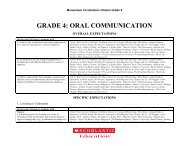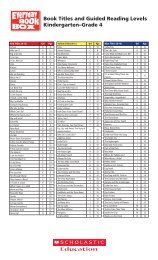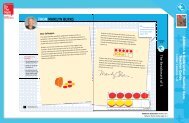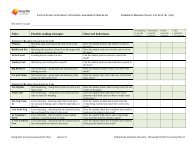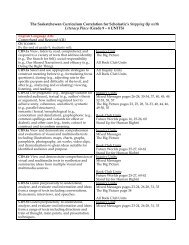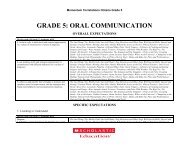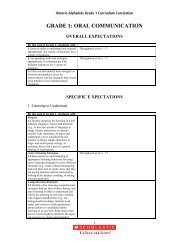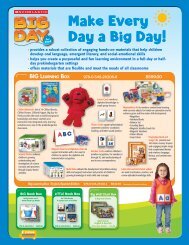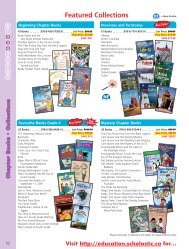Marilyn
Download a Sample - Scholastic
Download a Sample - Scholastic
- No tags were found...
Create successful ePaper yourself
Turn your PDF publications into a flip-book with our unique Google optimized e-Paper software.
Lesson15continuedAssessing student understandingCheck PointMonitor Progress and Differentiate InstructionUse the Annotated WorkSpace to assess pages 54 and 55. Although these lessons are carefully pacedand scaffolded, there may be instances when students need additional support or challenges.For Students Who Need More Support• If the student is not fluent with fractionsequivalent to 1 whole, have him or her make alist of these fractions using fraction strips andrecord them on paper: 1_ 1 , 2_ 2 , 3_ 3 , 4_ 4 , 6_ 6 , 8_ 8 , 12_ , and 16_ .To help the student apply that understandingto improper fractions and then mixed numbers,provide a list of fractions that are one unitfraction greater than 1 to convert to mixednumbers: 3_ 2 , 4_ 3 , 7_ 6 , 9_ 8 , 13_ 12 , and 17_ 16 . Have the studentcreate those fractions with fraction strips andthen convert them to mixed numbers with thesame method used when playing Roll Five.• If students have trouble with Roll Five, modify theactivity and have students play Roll Two or RollThree. As students gain confidence, have themplay Roll Four and finally Roll Five. Starting withRoll Two will give them practice with fraction sumsthat are less than or equal to one whole.• Play Roll Four or Roll Five with the student togive him or her practice with mixed numbersunder your guidance. Have the student use thewhole fraction strip to help write the mixednumber. For example, if the sum is 13_ 8 , thestudent should use the fraction strips to modelthat 13_ 8 is equivalent to 1 whole and 5 one-eighthpieces. Explain that another way to do thiswhen you don’t have the fraction strips is tobreak apart the fraction into one whole plus theremaining fraction.For Students Ready for a Challenge• Have students use small pieces of masking tape tolabel a fraction cube with the fractions 1_ 2 , 1_ 2 , 1_ 5 , 1_ 5 , 1_ 10 ,and 1_ 10 , and have them play Roll Five with this newfraction cube. Also, have students make fractionstrips for fifths and tenths with your guidance, usingtwo fifteen-inch strips of colors not used for thefraction kits, such as black and pink.• Have students place a small piece of masking tapeover one of the twelfths on the blue fraction cubeand label it 1_ 8 . Then have them play Roll Five withthe new fraction cube. Students will find that if theyget eighths and sixths or eighths and thirds, theywill need to use twenty-fourth strips. They can maketwenty-fourth strips by taking their green twelfthstrips and cutting them in half. If partners worktogether they only need to make one set of twentyfourths;this will preserve the twelfths from thepartner’s fraction kit.additionaL practiceNameUnit 7 ›› Lessons 11–15Use Comparing Fractions Toolkit StrategiesdirectionshhUse these strategies to compare each pair of fractions.Strategy 1: compare unit fractions 1_ 6 1_ 8DateStrategy 2: compare fractions with common numerators 3_ 12 3_ 4hhWrite or between each pair.additional practiceAll students could benefit from additional practice. For yourconvenience, the reproducible of the Additional Practice for Lessons11–15 is available on the TeacherSpace CD-ROM. This AdditionalPractice gives students more opportunities to compare unit fractionsand fractions with common numerators.1 1_ 23 3_ 85 5_ 67 4_ 99 6_ 71_33_105_84_882 1_ 44 _ 186 8_ 121_126_810 8_ 121_61_108_161_108_15TM ® & © Scholastic Inc. All rights reserved.126Reason With Fractions





